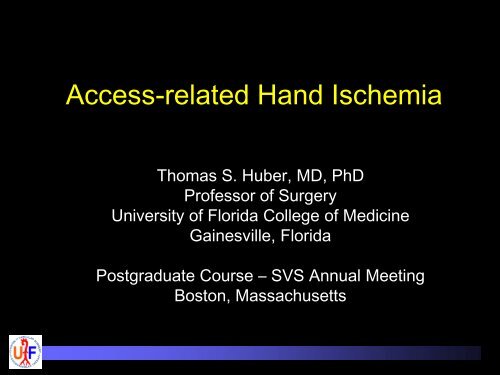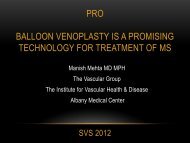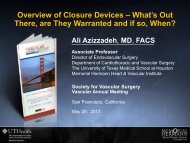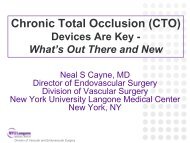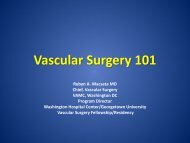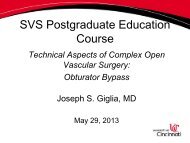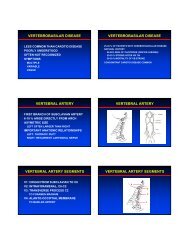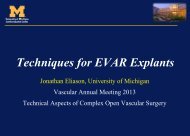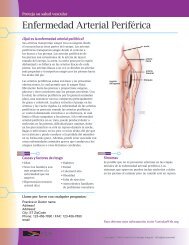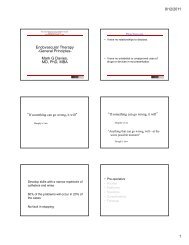Huber - VascularWeb
Huber - VascularWeb
Huber - VascularWeb
Create successful ePaper yourself
Turn your PDF publications into a flip-book with our unique Google optimized e-Paper software.
Access-related Hand Ischemia<br />
Thomas S. <strong>Huber</strong>, MD, PhD<br />
Professor of Surgery<br />
University of Florida College of Medicine<br />
Gainesville, Florida<br />
Postgraduate Course – SVS Annual Meeting<br />
Boston, Massachusetts
Disclosures<br />
None
Introduction<br />
• Hand ischemia - most worrisome<br />
“complication” after hemodialysis access.<br />
• Spectrum of symptoms (mild → severe).<br />
• “Complication” or adverse hemodynamic<br />
event within standard of care.<br />
*Access surgeons must be familiar with predictors, diagnosis, and treatment
Definitions and Classifications<br />
• Multiple terms and acronyms.<br />
– Access related ischemia (ARI)<br />
– Access related hand ischemia (ARHI)<br />
– Ischemic steal syndrome (ISS)<br />
– Dialysis associated steal syndrome (DASS)<br />
– Hemodialysis access induced distal ischemia (HAIDI)<br />
– Distal hypoperfusion ischemic syndrome (DHIS)<br />
*commonly described simply as “steal syndrome”
Definitions and Classifications<br />
• SVS Reporting Standards – “Steal”<br />
0 – none<br />
1 – mild cool extremity with few symptoms<br />
2 – moderate, ischemia during dialysis<br />
3 – severe, rest pain/tissue loss<br />
J Vasc Surg 2002;35:603.
Pathophysiology and Risk Factors<br />
• Low resistance circuit.<br />
• Distal perfusion<br />
variable, based on<br />
collaterals.<br />
• “Physiologic steal”<br />
usually tolerated.<br />
• Inflow/forearm PAOD<br />
decrease perfusion.<br />
*80% of patients with DBI – Vasc Endovasc Surg 2003;37:179
Pathophysiology and Risk Factors<br />
• Incidence (brachial artery-based access).<br />
– Symptoms 20%.<br />
– Intervention 10%.<br />
• Natural history poorly defined (selection).<br />
– Mild symptoms may improve.<br />
– Mod/serve symptoms do not improve.<br />
– Close follow-up mandatory<br />
*ischemia after radial-artery based access
Pathophysiology and Risk Factors<br />
• Clinical predictors<br />
– Advanced age<br />
– Female gender<br />
– Diabetes<br />
– Large conduit<br />
– PVOD<br />
– Multiple prior accesses<br />
– Prior hand ischemia<br />
• Noninvasive imaging<br />
– Finger pressure<br />
– DBI<br />
*Clinical factors, noninvasive studies with poor positive predictive value.
Clinical Presentation and Diagnosis<br />
• Classic symptoms<br />
(acute/chronic).<br />
• Clinical diagnosis –<br />
caution with pulses.<br />
• Limited differential.<br />
• Dialysis history key.<br />
• Noninvasive studies<br />
supportive.
Indications and Treatment<br />
• Goal - reverse ischemia/preserve access.<br />
• Indications – moderate/severe ischemia.<br />
• Multiple (complementary) treatments.<br />
*Ischemic neuropathy may not be reversible.
Indications and Treatment<br />
• Access ligation.<br />
• Correct inflow stenosis.<br />
• Flow-limiting (e.g. “banding”).<br />
• Proximalization of arterial inflow (PAI).<br />
• Ligation of artery distal to anastomosis.<br />
• Distal revascularization/interval ligation (DRIL).<br />
• Distal revascularization without ligation
Indications and Treatment<br />
• Hemodynamic impact – ex vivo.<br />
– Flow limiting effective.<br />
– DRIL and PAI with dramatic effect.<br />
– Ligation component of DRIL minimal effect.<br />
J Vasc Surg 2008;48:1559<br />
Ann Vasc Surg 2004;18:59
Indications and Treatment<br />
• Clinical determinants of treatment.<br />
– Cause of ischemia (possible inflow).<br />
– Potential utility of access.<br />
– Future access options (recurrence).<br />
– Patient comorbidities.<br />
– Available conduit.<br />
*DRIL for acute symptoms and reasonable autogenous access
Indications and Treatment<br />
• “Flow limiting” (banding).<br />
– Abandoned resurgence.<br />
– Balance perfusion/access flow.<br />
– Hemodynamics/biology dynamic.<br />
– Potential with objective measurements for<br />
“high flow” accesses (> 1.2 L/min)<br />
*Not effective for extensive tissue loss.<br />
J Vasc Surg 2006;44:1273<br />
Arch Surg 2007;392:204
Indications and Treatment<br />
• Proximalization of arterial inflow (PAI)<br />
– Variant of “flow limiting” procedure.<br />
– Does not require ligating axial artery.<br />
– Potential for patients without conduit.<br />
– Autogenous → prosthetic access.<br />
– Limited published experience.<br />
*Not effective for extensive tissue loss.<br />
J Vasc Surg 2006;43:1216<br />
Ann Vasc Surg 2008;23:485
Indications and Treatment<br />
• Distal revascularization/interval ligation<br />
– Most accepted/durable.<br />
– Requires ligating axial artery.<br />
– Hand dependent upon bypass.
Indications and Treatment<br />
• Preoperative (preemptive) planning.<br />
– Identify/correct all inflow lesions.<br />
– Operative plan to limit ischemia.<br />
– Remedial plan for ischemia.<br />
– Potential vein survey for DRIL.
UF DRIL - Patients<br />
Demographics N = 61<br />
Age 59 13<br />
Gender (% female) 62%<br />
Comorbidities<br />
ESRD 92%<br />
Hypertension 74%<br />
Diabetes Mellitus 72%<br />
Coronary Artery Disease 36%<br />
Congestive Heart Failure 20%<br />
Prior Access-related Ischemia 10%<br />
*6% of new access procedures required DRIL – J Vasc Surg 2008;48:926
UF DRIL - Procedures<br />
Auto Radiocephalic 0<br />
Auto Radiobasilic 0<br />
Auto Brachiocephalic 46%<br />
Auto Brachiobasilic 31%<br />
Auto BA Translocated Femoral 20%<br />
Prosthetic Brachioaxillary 3%<br />
J Vasc Surg 2008;48:926
Percentage (%)<br />
UF DRIL – Presenting Symptoms<br />
50<br />
40<br />
34<br />
30<br />
25<br />
24<br />
20<br />
17<br />
10<br />
0<br />
Pain Paresthesia Motor Tissue<br />
Loss<br />
*Preemptive DRIL N = 5<br />
J Vasc Surg 2008;48:926
Percentage (%)<br />
UF DRIL – Timing of Procedure<br />
50<br />
44<br />
40<br />
30<br />
29<br />
20<br />
19<br />
10<br />
0<br />
< 1 day 1 - 7 days 7 - 30 days > 30 days<br />
8<br />
J Vasc Surg 2008;48:926
UF DRIL - Technique<br />
• Proximal bypass<br />
anastomosis > 7cm<br />
from fistula.<br />
• Distal anastomosis<br />
functional end/end to<br />
brachial artery.<br />
• Autogenous v > 3 mm.<br />
• Inflow arteriogram.<br />
J Vasc Surg 2008;48:926
UF DRIL - Outcome<br />
Mortality 3%<br />
Morbidity 22%<br />
Wound 14%<br />
Respiratory 3%<br />
Vascular 3%<br />
Cardiac 2%<br />
J Vasc Surg 2008;48:926
UF DRIL - Outcome<br />
Paresthesia<br />
Motor<br />
Tissue Loss<br />
Pain<br />
None<br />
*Ischemic neuropathy may not be reversible.<br />
J Vasc Surg 2008;48:926
UF DRIL - Outcome<br />
1<br />
0.8<br />
* *<br />
0.79<br />
0.7<br />
0.6<br />
0.4<br />
0.46<br />
0.25<br />
Pre<br />
Post<br />
0.2<br />
0<br />
WBI<br />
FBI<br />
J Vasc Surg 2008;48:926
UF DRIL - Outcome<br />
Access – Immature<br />
(67%)<br />
Access – Mature<br />
(33%)<br />
Mature - 68% Fail - 32%<br />
Continue – 100% Early Failure - 0<br />
J Vasc Surg 2008;48:926
J Vasc Surg 2008;48:926
J Vasc Surg 2008;48:926
Summary/Conclusions<br />
• Access-related hand ischemia is an<br />
adverse hemodynamic event.<br />
• Predictable based upon patient<br />
characteristics and noninvasive studies.<br />
• Clinical diagnosis corroborated with<br />
noninvasive studies.
Summary/Conclusions<br />
• Goal to reverse ischemia/salvage access.<br />
• Multiple complementary treatment options<br />
• DRIL is a safe, effective treatment.<br />
– Symptomatic relief > 90%.<br />
– Acceptable bypass graft patency.<br />
– Preserves both hand and access.
Go GATORS
Case Presentation<br />
• HPI – 51 yo thin male with history of ESRD. Multiple<br />
failed LUE access procedures.<br />
• PMH – noncontributory.<br />
• PE – 2+ bilateral brachial/radial pulses. Multiple surgical<br />
incisions, palpable prosthetic access.<br />
• Vascular laboratory – no suitable peripheral veins,<br />
arterial pressures equal/symmetric, no central vein<br />
problems
Case Presentation - Continued<br />
• Surgical procedure – R brachioaxillary<br />
prosthetic access with 6 mm PTFE.<br />
• Perioperative outcome – grade III hand<br />
ischemia.<br />
• Vascular laboratory – no LE vein.
Case Presentation - Continued<br />
• Remedial treatment – arteriogram without<br />
inflow lesion, definitive treatment with<br />
ligation.<br />
• Approach to subsequent access.
Case Presentation<br />
• HPI – 60 year old obese female with ESRD for<br />
13 years, 57 prior access-related procedures<br />
currently dialyzing through a brachioaxillary<br />
prosthetic access (8 mm PTFE), venous<br />
anastomosis infraclavicular. Access noted be<br />
occluded at dialysis unit.<br />
• PE – obese female, multiple arm incisions,<br />
obvious graft thrombosis.
Case Presentation - Continued<br />
• Surgical procedure – open mechanical<br />
thrombectomy, venogram with central vein<br />
occlusion.
Case Presentation - Continued<br />
• Surgical procedure – central vein<br />
angioplasty with 14 mm balloon.<br />
• Remedial treatment


